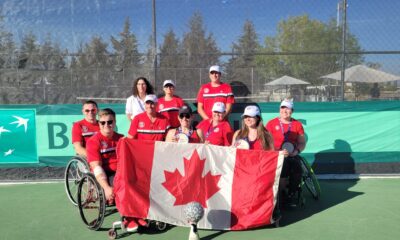This is part three of the four part series on tennis, which might be one sport you can play while being socially distanced from everyone on the court.
Enjoy Part Three
This refers to the amount of deflection that the frame experiences after contact with the ball. Like we noted above, the stiffness of the frame has a huge impact on power.
Stiffer frames bend less after contact with the ball, which in turn means that less energy gets lost. More flexible frames, on the other hand, bend more, which translates to greater energy loss.
There is a common misconception among some players that flexible frames result in more power due to the catapult effect. However, this is not true.
The ball is usually in contact with the strings for about 3-5 milliseconds, which is not enough time for the catapult effect to kick in.
This means that none of the energy is returned to the ball. All of it gets absorbed by the frame. The less stiff the frame, the more the energy that gets absorbed.
The impact of frame stiffness goes beyond power. It also affects your control and comfort. When it comes to tennis racquet, there is a general understanding that to get more power, one has to sacrifice control, and vice versa.
However, this is not a hard rule. It depends largely on the type of player as well as their ability.
For instance, some advanced players might opt for flexible rackets because the player has developed a long, fast and powerful swing.
For such a player, a stiff racket would provide excessive power, which would result in too many long balls. On the other hand, a beginner or intermediate player might find better control in a stiffer frame that doesn’t experience lots of deflection on impact.
Similarly, experienced players who have short, compact strokes might also find more control from a stiffer frame.
Again, stiffer frames are usually deemed to be less comfortable than flexible ones, since they tend to transmit more impact shock to the arms.
It’s good to keep in mind that comfort is a relative factor that cannot be measured accurately – whatever feels comfortable depends on the player.
However, if you have arm or shoulder problems, its best to avoid extremely stiff frames. Finally, you should note that the frame stiffness also has an impact on the amount of spin. Generally, stiffer frames lead to less spin, since the ball spends less time on the string bed.
String Pattern
This is an important factor that most recreational players tend to overlook. The string pattern and density plays a role in the overall feel and performance of a tennis racket. String pattern and density is classified into two categories – open and closed.
Open string patterns experience more deflection upon impact with the ball, which in turn results into greater rebound.
If you take two similar tennis racquets that are strung at the same tension, the open string pattern will feel “loose” compared to the closed string pattern.
Since the open string pattern has wider spaces between the strings, the ball tends to embed itself further into the strings, which gives open string patterns rackets higher spin potential.
On the downside, open string patterns are less durable. Since the strings can move more freely, they experience more abrasion, which increases the likelihood of breakage.
Closed string patterns feel “tighter” and experience less deflection on impact, which leads to less rebound energy. Owing to this “tightness”, closed string patterns also have less spin potential.
However, they are significantly more durable than open string patterns. If you prefer enhanced control and you are not particularly concerned about spin, your best option is a closed string pattern racket.
These rackets are also a good choice for hard-hitting players who want more durability.
Our Pick
Our pick for the best tennis racquet is the Wilson blade 98 18×20. This is a high end tennis racquet that is preferred by many professional players.
The Wilson blade 98 18×20 is lighter than most high end rackets and has minimal vibrations. The Blade 98 delivers stable and robust strikes.
It’s good to note that the racket is head-heavy. This helps provide more power on strike and direct driven shots deep into the opponent’s’ side of the court.
Some testers noted the racket’s blade made it harder for them to feel the ball at contact.
However, the Wilson Blade 98’s stability, pinpoint precision, and friendly feel makes it the best choice for advanced and intermediate tennis players.
At 320 grams the Wilson blade 98 18×20 has a solid feel and delivers controlled strikes from back court. From our tests the blade 98 18×20 delivers shots of 47 pounds.
The racquet offers good maneuverability and stability. It also offers a solid backhand and a nice slice, something that most tennis players will enjoy.
The Wilson Blade 98 18×20 performs optimally in all parts of the court. The precision and control offered by the racket make it possible to handle hard and soft volleys even when close to the net.
The strong tight string pattern of the racket offers the best response to volleys and gives nice volleyed shots from behind the net.
When it comes to serves the Wilson blade 98 18×20 performs excellently, offering plenty of pace and spin on the ball.
The weight of the racket translates to a high swing weight, but the control that comes with the weight is totally worth it.
The weight coupled with the tight strings sends the ball nicely through the court at a good pace.
The maneuverability, precision and control of the Wilson Blade 98 is also quite evident on service returns.
You will also enjoy the solid but smooth feel on chip shots and slices.
If you want to promote your business let Sportswave help you. by sending us an e-mail to sportswave@dccnet.com
Contact us for more information.








